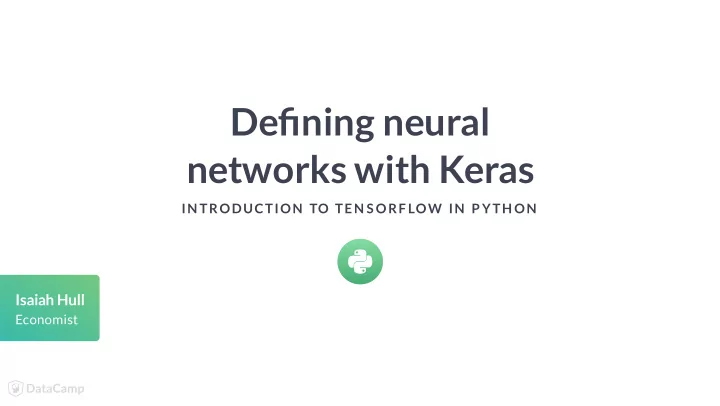

De�ning neural networks with Keras IN TRODUCTION TO TEN S ORF LOW IN P YTH ON Isaiah Hull Economist
Classifying sign language letters INTRODUCTION TO TENSORFLOW IN PYTHON
The sequential API INTRODUCTION TO TENSORFLOW IN PYTHON
The sequential API Input layer Hidden layers Output layer Ordered in sequence INTRODUCTION TO TENSORFLOW IN PYTHON
Building a sequential model # Import tensorflow from tensorflow import keras # Define a sequential model model = keras.Sequential() # Define first hidden layer model.add(keras.layers.Dense(16, activation='relu', input_shape=(28*28,))) INTRODUCTION TO TENSORFLOW IN PYTHON
Building a sequential model # Define second hidden layer model.add(keras.layers.Dense(8, activation='relu')) # Define output layer model.add(keras.layers.Dense(4, activation='softmax')) # Compile the model model.compile('adam', loss='categorical_crossentropy') # Summarize the model print(model.summary()) INTRODUCTION TO TENSORFLOW IN PYTHON
The functional API INTRODUCTION TO TENSORFLOW IN PYTHON
Using the functional API # Import tensorflow import tensorflow as tf # Define model 1 input layer shape model1_inputs = tf.keras.Input(shape=(28*28,)) # Define model 2 input layer shape model2_inputs = tf.keras.Input(shape=(10,)) # Define layer 1 for model 1 model1_layer1 = tf.keras.layers.Dense(12, activation='relu')(model1_inputs) # Define layer 2 for model 1 model1_layer2 = tf.keras.layers.Dense(4, activation='softmax')(model1_layer1) INTRODUCTION TO TENSORFLOW IN PYTHON
Using the functional API # Define layer 1 for model 2 model2_layer1 = tf.keras.layers.Dense(8, activation='relu')(model2_inputs) # Define layer 2 for model 2 model2_layer2 = tf.keras.layers.Dense(4, activation='softmax')(model2_layer1) # Merge model 1 and model 2 merged = tf.keras.layers.add([model1_layer2, model2_layer2]) # Define a functional model model = tf.keras.Model(inputs=[model1_inputs, model2_inputs], outputs=merged) # Compile the model model.compile('adam', loss='categorical_crossentropy') INTRODUCTION TO TENSORFLOW IN PYTHON
Let's practice! IN TRODUCTION TO TEN S ORF LOW IN P YTH ON
Training and validation with Keras IN TRODUCTION TO TEN S ORF LOW IN P YTH ON Isaiah Hull Economist
Overview of training and evaluation 1. Load and clean data 2. De�ne model 3. Train and validate model 4. Evaluate model INTRODUCTION TO TENSORFLOW IN PYTHON
How to train a model # Import tensorflow import tensorflow as tf # Define a sequential model model = tf.keras.Sequential() # Define the hidden layer model.add(tf.keras.layers.Dense(16, activation='relu', input_shape=(784,))) # Define the output layer model.add(tf.keras.layers.Dense(4, activation='softmax')) INTRODUCTION TO TENSORFLOW IN PYTHON
How to train a model # Compile model model.compile('adam', loss='categorical_crossentropy') # Train model model.fit(image_features, image_labels) INTRODUCTION TO TENSORFLOW IN PYTHON
The �t() operation Required arguments features labels Many optional arguments batch_size epochs validation_split INTRODUCTION TO TENSORFLOW IN PYTHON
Batch size and epochs INTRODUCTION TO TENSORFLOW IN PYTHON
Performing validation INTRODUCTION TO TENSORFLOW IN PYTHON
Performing validation # Train model with validation split model.fit(features, labels, epochs=10, validation_split=0.20) INTRODUCTION TO TENSORFLOW IN PYTHON
Performing validation INTRODUCTION TO TENSORFLOW IN PYTHON
Changing the metric # Recomile the model with the accuracy metric model.compile('adam', loss='categorical_crossentropy', metrics=['accuracy']) # Train model with validation split model.fit(features, labels, epochs=10, validation_split=0.20) INTRODUCTION TO TENSORFLOW IN PYTHON
Changing the metric INTRODUCTION TO TENSORFLOW IN PYTHON
The evaluation() operation # Evaluate the test set model.evaluate(test) INTRODUCTION TO TENSORFLOW IN PYTHON
Let's practice! IN TRODUCTION TO TEN S ORF LOW IN P YTH ON
Training models with the Estimators API IN TRODUCTION TO TEN S ORF LOW IN P YTH ON Isaiah Hull Economist
What is the Estimators API? High level submodule Less �exible Enforces best practices Faster deployment Many premade models 1 Image taken from https://www.tensor�ow.org/guide/premade_estimators INTRODUCTION TO TENSORFLOW IN PYTHON
Model speci�cation and training 1. De�ne feature columns 2. Load and transform data 3. De�ne an estimator 4. Apply train operation INTRODUCTION TO TENSORFLOW IN PYTHON
De�ning feature columns # Import tensorflow under its standard alias import tensorflow as tf # Define a numeric feature column size = tf.feature_column.numeric_column("size") # Define a categorical feature column rooms = tf.feature_column.categorical_column_with_vocabulary_list("rooms",\ ["1", "2", "3", "4", "5"]) INTRODUCTION TO TENSORFLOW IN PYTHON
De�ning feature columns # Create feature column list features_list = [size, rooms] # Define a matrix feature column features_list = [tf.feature_column.numeric_column('image', shape=(784,))] INTRODUCTION TO TENSORFLOW IN PYTHON
Loading and transforming data # Define input data function def input_fn(): # Define feature dictionary features = {"size": [1340, 1690, 2720], "rooms": [1, 3, 4]} # Define labels labels = [221900, 538000, 180000] return features, labels INTRODUCTION TO TENSORFLOW IN PYTHON
De�ne and train a regression estimator # Define a deep neural network regression model0 = tf.estimator.DNNRegressor(feature_columns=feature_list,\ hidden_units=[10, 6, 6, 3]) # Train the regression model model0.train(input_fn, steps=20) INTRODUCTION TO TENSORFLOW IN PYTHON
De�ne and train a deep neural network # Define a deep neural network classifier model1 = tf.estimator.DNNClassifier(feature_columns=feature_list,\ hidden_units=[32, 16, 8], n_classes=4) # Train the classifier model1.train(input_fn, steps=20) https://www.tensor�ow.org/guide/estimators INTRODUCTION TO TENSORFLOW IN PYTHON
Let's practice! IN TRODUCTION TO TEN S ORF LOW IN P YTH ON
Congratulations! IN TRODUCTION TO TEN S ORF LOW IN P YTH ON Isaiah Hull Economist
What you learned Chapter 1 Low-level, basic, and advanced operations Graph-based computation Gradient computation and optimization Chapter 2 Data loading and transformation Prede�ned and custom loss functions Linear models and batch training INTRODUCTION TO TENSORFLOW IN PYTHON
What you learned Chapter 3 Dense neural network layers Activation functions Optimization algorithms Training neural networks Chapter 4 Neural networks in Keras Training and validation The Estimators API INTRODUCTION TO TENSORFLOW IN PYTHON
TensorFlow extensions TensorFlow Hub Pretrained models Transfer learning TensorFlow Probability More statistical distributions Trainable distributions Extended set of optimizers 1 Screenshot from https://tfhub.dev. INTRODUCTION TO TENSORFLOW IN PYTHON
TensorFlow 2.0 T ensorFlow 2.0 eager_execution() Tighter keras integration Estimators 1 Screenshot taken from https://www.tensor�ow.org/guide/premade_estimators INTRODUCTION TO TENSORFLOW IN PYTHON
Congratulations! IN TRODUCTION TO TEN S ORF LOW IN P YTH ON
Recommend
More recommend